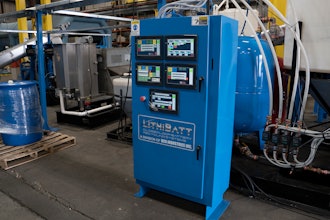Joseph Weigel, Product Manager, Square D Services Marketing
Personal Protective Equipment (PPE) is the last line of defense for protecting workers from arc-flash hazards -- the uncontrolled release of energy during an arcing fault. An arc fault, or fault current that travels through the air, releases a high amount of energy in the form of heat and pressure. In an arc-flash situation, equipment is usually damaged and workers are typically injured or even killed.
With as many as 5-10 serious arc-flash incidents occurring each day in the United States, resulting in burn injuries and fatalities, PPE continues to be an important safety component for companies. PPE comes in a range of protective ratings, and making sure workers are properly outfitted can be a complex process.
Step 1: Understanding PPE Levels
NFPA 70E-2004 defines five PPE categories based on the degree of protection each provides. Each category is assigned an Arc Rating based on calories per square centimeter (cal/cm²), which defines a material's maximum incident energy resistance. It's best to refer to NFPA 70E-2004 for complete clothing requirements, but here are the basics for each Hazard/Risk Category:
- Category 0: One layer of untreated natural fiber clothing; no minimum PPE Arc Rating (cal/cm²).
- Category 1: Fire-resistant shirt and fire-resistant pants; one total layer. Minimum PPE Arc Rating: 4 cal/cm².
- Category 2: Category 1 plus cotton underwear; two total layers. Minimum PPE Arc Rating: 8 cal/cm².
- Category 3: Category 2 plus fire-resistant coverall; three total layers. Minimum PPE Arc Rating: 25 cal/cm².
- Category 4: Category 2 plus multilayer flash suit; four total layers. Minimum PPE Arc Rating: 40 cal/cm².
Non-fire resistant cotton has no arc rating and is only allowable at locations or working distances demonstrating extremely low available incident energy potential. Non-fire resistant clothing, like synthetic blends, is forbidden because it can easily ignite and/or melt into the skin and aggravate a burn injury. The best rule of thumb is that things change dramatically for a worker once he or she enters the flash-protection boundary (defined by NFPA 70E-2004 Article 100-1 as an approach limit at a distance from exposed live parts within which a person could receive a second-degree burn if an electrical arc flash were to occur). As the incident energy level increases, the Hazard/Risk Category (defined by NFPA 70E-2004 Article 100-1 as the amount of energy impressed on a surface a certain working distance from a source generated during an electric arcing event) increases as well.
Step 2: Choosing a Calculation Method
Several methods are available for calculating potential arc-flash incident energy and flash protection boundary during a release so workers can wear the appropriate amount of PPE. However, it bears mentioning that arc-flash hazard calculations are extremely complex and should be done by an electrical engineer familiar with calculation methods. The most important methods for calculating arc-flash hazard potential include NFPA 70E-2004, IEEE Std 1584-2002 and equipment-specific equations.
Section 130.3(A) of NFPA 70E-2004 includes equations that can be used to calculate flash-protection boundary distances for systems operating at 600 V or less. Flash-protection boundary for systems operating at above 600 V is characterized as the point where the incident energy level equals 1.2 cal/cm². It also provides a method that requires little or no calculation -- a table in Section 130.7(C)(9)(a) with Hazard/Risk Category values for typical work tasks for common equipment is available. These Hazard/Risk categories are estimates based on actual calculations, but strict attention should be paid to footnotes referenced in the table. The categories are conservative and in many cases will overstate the requirement. A worker can simply find the appropriate work task in the table, but for system conditions that fall outside the defined fault current ranges and fault clearing times, the tables should not be used to choose PPE. Additionally, for some conditions that do fit the system, the recommended PPE may be inadequate.
IEEE Std 1584-2002 provides the most comprehensive set of equations for calculating incident energy levels and flash-protection boundaries, presenting equations that cover systems at voltage levels ranging from 208 V to 15 kV and for available bolted fault currents ranging from 700 A to 106 kA, which will cover a majority of low- and medium-voltage installations. Simplified equations are also provided for several common protective device types.
General equations provided in IEEE Std 1584 can't possibly reflect the performance of every protective device in every possible situation; they may not adequately portray current-limiting action of fuses or circuit breakers and can provide overly conservative results. That's why equipment-specific equations, like those developed for Square D® Masterpact® NW and NT low-arc flash (LF and L1F) circuit breakers, are extremely helpful.
Step 3: Obtaining the Best Results
No calculation method is applicable to all situations, but there are several steps an engineer can follow to ensure they can arrive at the best results:
- Verify that actual system conditions fall within the chosen method's range of applicability.
- Use newer test results, industry standards, and calculation methods, which are more likely to accurately represent actual hazard levels than older methods.
- Know which device clears the fault and use accurate fault current values in calculations.
- Quantify variables like the distance from the electric arc to a worker's face and body; the bus gap, or the gap between phase conductors or from phase to ground; equipment configuration; system grounding and voltage, level of arcing fault current; and fault clearing.
- Be aware of motor contribution, because its action will in some cases contribute to the arcing fault current.
- Read the fine print. When comparing results from different calculation methods, an engineer should be aware that even those based on the same set of test data may have variations that make it impossible for a direct comparison.
- Whenever they are available, device-specific equations should be used rather than general calculation methods to provide more accurate data.
PPE Not a Replacement for Safety
When properly utilized, the various calculation methods are a great means of determining the right amount of PPE a worker should wear. But PPE is not a replacement for safe work practices or engineering controls that can reduce a worker's exposure to arc-flash hazards. The best practice is always to place electrical equipment into an electrically safe condition prior to working on it, when operational conditions permit. For further information on safe work practices, consult NFPA 70E-2004.























